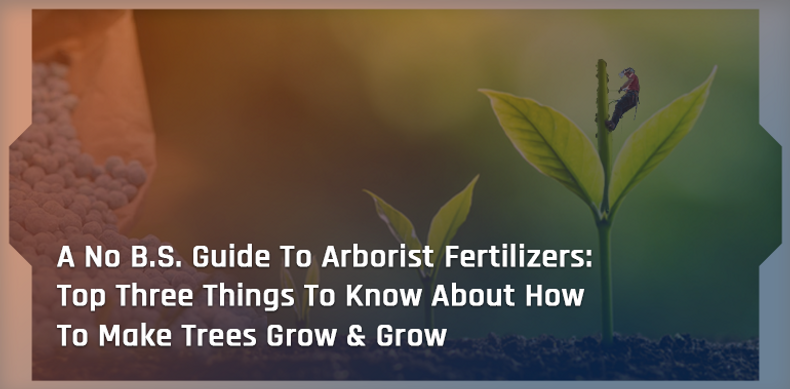What’s that smell?
Oh yes- it is the familiar and ever so wonderful smell of fertilizer. All joking aside, not all fertilizer really smells bad. Mulch can smell pretty dang nice.
If you are getting ready to become an arborist, you will need to know more than a few things about fertilizer. In fact, you will need to know a lot about fertilizer.
But you will need a place to start, and that is why you are here. We are gonna give you a very short list of three general categories that you will need to learn about.
This one is for all of you tree workers, arborists, tree surgeons in training, as well as you rascally amateur fans of arboriculture.
Related Posts:
A. Plant Health Care: Saving The Environment & Your Wallet
B. A Guide To When A Tree Needs Care
1. Don’t Panic- Go Organic (Or Go Inorganic Every Once In A While)
Have you ever been to a Whole Foods or Trader Joe’s market? Have you talked to hot moms about organic food and yoga?
It turns out that aside from people who like to spend a lot of money on food, trees also like organic food. As far as we know they don’t care much for yoga pants though.
For the most part, organic fertilizers are the best for trees because they release nutrients like nitrogen into the soil real slow and easy. This means that fewer nutrients are lost in the process.
Advantages To Using Organic Fertilizers:
- Less Likely To Cause Root Burn
- A Slower Release Of Nutrients Into The Soil
- Helps Trees To Build Natural Defenses Against Pests
- Encourages Healthy Soil, Rather Than Causing Soil Damage
- Helps Trees To Build Natural Defenses Against Weather & Drought
Mulches and organic fertilizers in general also help trees build their natural defenses to pests and the elements. That is pretty cool, right?
Inorganic fertilizer is becoming less and less popular because it does things like causing root burn. This reduces growth and turns the leaves a super ugly brown or yellow color? Do you want that? Not unless you are sadistic toward plants.
But y’know, every once in a blue moon, the use of inorganic fertilizers may be justified. Inorganic fertilizers dissolve very quickly in emergency applications.
2. Timing Is Everything (Not EVERYTHING Everything, But Pretty Important)
You will need to know about the right times and rates to use fertilizers.
For the most part, plants absorb nitrogen best during the Summer and Spring. It’s probably good to use fertilizer when it is going to work best, but that could be seen as just an opinion.
Important Factors To Picking When To Use Fertilizer:
- Tree Species
- Age Of The Tree
- Health Of The Tree
It is pretty important to be conservative in the rate of fertilization, as using too much fertilizer can cause excessive runoff that will contaminate nearby water sources. If you are into that, you are not a good person.
You will also need to learn to think about cations. “What is a cation?” you ask. It’s a positive charge in ions that determines how well a tree can exchange nutrients with the soil.
Clay soil is pretty good when it comes to those positive ions. You will want to learn a good amount about how to use slow-release fertilizers in sandy soils too. Sound interesting to you? If so, you will love being an arborist.
3. A Method To The Madness (Or A Method To Sensible Fertilizing- You Pick)
It is pretty important that you learn about different methods of applying fertilizer.
Some Methods Of Applying Fertilizer:
- Implanting
- Liquid Injections
- Drill Hole Methods
- Surface Applications
- Subsurface Applications
According to PHC Philosophy (Plant Healthcare, not Pilsbury Hardcore), you will want to do as little harm to a tree as possible. Some quick fixes to problems with trees can be very damaging to a tree in the long run. You can damage the bark and structure of a tree, weaken or diminish its roots, ruin its soil, or cause water pollution.
Implanting fertilizer, in particular, can be very damaging to trees, especially if they are already suffering from damages from draught or general dryness.
In general, subsurface (below the turf) and surface applications are the most commonly used methods of applying fertilizer.
Surface applications will get to the most active parts of roots but can sometimes cause excessive runoff into rivers and streams.
Where To Go Next
Well, we kept our promise. We gave you three different subjects to start looking into if you are thinking about becoming an arborist. Learning about fertilizers is a very important part of being an arborist and is also something you will need to know for your tests to get certified.
The Arborist’s Certification Study Guide from the ISA includes some more in-depth information on all of these subjects, and if you are getting ready to take your test, you will want to review it, in case that is not already obvious. Unfortunately, it won’t include any jokes about bull manure or fun rhymes, but that’s what you come to us for, right?





